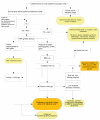Novel observations in hereditary hemochromatosis: potential implications for clinical strategies
- PMID: 21454877
- PMCID: PMC3069220
- DOI: 10.3324/haematol.2011.042036
Novel observations in hereditary hemochromatosis: potential implications for clinical strategies
Figures


Comment on
-
A time course of hepcidin response to iron challenge in patients with HFE and TFR2 hemochromatosis.Haematologica. 2011 Apr;96(4):500-6. doi: 10.3324/haematol.2010.033449. Epub 2010 Dec 20. Haematologica. 2011. PMID: 21173098 Free PMC article.
-
Iron overload in HFE C282Y heterozygotes at first genetic testing: a strategy for identifying rare HFE variants.Haematologica. 2011 Apr;96(4):507-14. doi: 10.3324/haematol.2010.029751. Epub 2011 Jan 12. Haematologica. 2011. PMID: 21228038 Free PMC article.
References
-
- Feder JN, Gnirke A, Thomas W, Tsuchihashi Z, Ruddy DA, Basava A, et al. A novel MHC class I-like gene is mutated in patients with hereditary haemochromatosis. Nat Genet. 1996;13(4):399–408. - PubMed
-
- Swinkels DW, Janssen MC, Bergmans J, Marx JJ. Hereditary hemochromatosis: genetic complexity and new diagnostic approaches. Clin Chem. 2006;52(6):950–68. - PubMed
-
- Hentze MW, Muckenthaler MU, Galy B, Camaschella C. Two to tango: regulation of mammalian iron metabolism. Cell. 2010;142(1):24–38. - PubMed
Publication types
MeSH terms
Substances
LinkOut - more resources
Full Text Sources
Medical

